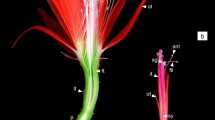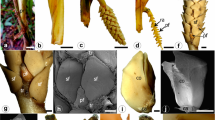Abstract
Ficus carica L. is one of the ≅700 species of the Ficus genus in the Moraceae family (Flaishman et al., 2008; Datwyler & Weiblen, 2004). The cultivated fig, Ficus carica L. (Moraceae), is clearly of greatest importance as a source of human food in some areas of the world. The fig fruit has long been associated with horticulture in the Mediterranean region, which is well adapted to drought and high temperatures (Zohary & Spiegel-Roy, 1975). Cato, Pliny the Elder, and Columella described horticultural practices (for example, tillage and fertilization) and fig cultivars (African, Winter, Tiburtine, Pompeian, Herculanean, Saguntine). However, they did not specifically describe the breba or first crop (generally ripening in May–June) and the main crop (ripening in July–September). Information is scarce regarding the time of initiation and differentiation of flower buds, considering the limited research existing up to now. This chapter’s purpose is to describe better the morphology, type, and structure of the fig buds and the differentiation and formation processes that occur during the bud growth season. Inflorescences initiation and differentiation occur in the develo** buds of the young shoot throughout the growing season until early summer. Breba figs are produced from flower buds, which differentiate the year before fruit maturity. Main crop figs are produced from buds differentiated during the season in which the fruit matures. The mixed buds start to develop undifferentiated inflorescence primordia at the end of the winter (with increasing temperature), which will differentiate almost complete inflorescences within 2–3 months both for breba (for the successive season) and the main crop (for the current season). The most productive part of the shoot is the middle portion, while the buds on the basal and distal nodes of the shoot are the least productive.
Access this chapter
Tax calculation will be finalised at checkout
Purchases are for personal use only
Similar content being viewed by others
References
Condit, I. J. (1947). The fig (pp. 1–222). Chronica Botanica.
Crabbe, J. (1994). Dormancy. In Encyclopedia of agricultural science (Vol. 1). Academic.
Crabbe, J., & Barnola, P. (1996). A new conceptual approach to bud dormancy in woody plants. In G. A. Lang (Ed.), Plant dormancy: Physiology, biochemistry and molecular biology (pp. 83–113). CAB International.
Datwyler, S. L., & Weiblen, G. D. (2004). On the origin of the fig: phylogenetic relationships of Moraceae from ndhF sequences. American Journal of Botany, 91, 767–777. https://doi.org/10.3732/ajb.91.5.767
Davie, S. J., Stassen, P. J. C., & Van Der Walt, M. (1995). Girdling for increased fruit size and its effect on carbohydrate production and storage. Proceedings of the World Avocado Congress, III, 25–28.
Duric, G., Micic, N., & Dabie, G. (1992). Jugoslovensko Vocarstvo, 26, 15–21.
Eisen, G. (1901). The fig: Its history, culture, and curing. Government Printing Office.
Ersoy, N., Gozlekci, S., Kaynak, L., Dal, B. and Yazıcı, K. (2008). Relationship among the shoot, leaf and fruit growth of some FIG (Ficus carica) cultivars grown in antalya conditions. Acta Horticulturae, 798, 143–148 https://doi.org/10.17660/ActaHortic.2008.798.19
Faust, M., Liu, D., Wang, S. Y., & Stutte, G. W. (1995). Involvement of apical dominance in winter dormancy of apple buds. Acta Horticulturae, 395, 47–56.
Faust, M., Erez, A., Rowland, L. J., Wang, S. Y., & Norman, H. A. (1997). Bud dormancy in perennial fruit trees: Physiological basis for dormancy induction, maintenance, and release. HortScience, 32(4), 623–629.
Ferguson, L., Michailides, T. J., & Shorey, H. H. (1990). The California fig industry. Horticultural Reviews, 12, 409–490.
Ferrara, G., Mazzeo, A., Netti, G., Pacucci, C., Matarrese, A. M. S., Cafagna, I., Mastrorilli, P., Vezzoso, M., & Gallo, V. (2014). Girdling, gibberellic acid, and forchlorfenuron: Effects on yield, quality, and metabolic profile of table grape cv. Italia. American Journal of Enology and Viticulture, 65, 381–387.
Ferrara, G., Mazzeo, A., Pacucci, C., Matarrese, A. M. S., Tarantino, A., Crisosto, C., Incerti, O., Marcotuli, I., Nigro, D., Blanco, A., Gadaleta. A. (2016). Characterization of edible fig germplasm from Puglia, southeastern Italy: is the distinction of three fig types (Smyrna, San Pedro and Common) still valid? Scientia Horticulturae, 250, 52–58. https://doi.org/10.1016/j.scienta.2016.04.0016.
Ferrara, G., Mazzeo, A., Gallotta, A., Pacucci, C., Matarrese, A. M. S., Tarantino, A., Incerti, O., Marcotuli, I., Nigro, D., Blanco, A., Gadaleta, A. (2017). Fruit-set and SSR markers of fig cultivars from Puglia region, Southeastern Italy. Acta Horticulturae, 1173, 39-43. https://doi.org/10.17660/ActaHortic.2017.1173.7.
Flaishman, M. A., Rover, V., & Stover, E. (2008). The fig: Botany, horticulture, and breeding. Horticultural Reviews, 34, 113–197.
Gaaliche, B., Lauri, P. E., Trad, M., Costes, E., and Mars, M. (2011). Interactions between vegetative and generative growth and between crop generations in fig tree (Ficus carica L.). Scientia Horticulturae, 131, 22–28. https://doi.org/10.1016/j.scienta.2011.09.022
Gerber, H. J., Steyn, W. J., & Theron, K. I. (2010). The optimum one-year-old shoot length to optimize yield and fruit size of three fig (Ficus carica L.) cultivars. HortScience, 45, 1321–1326.
Grassi G., (1991). Il Fico. Collana Manuali pratici. Ed. Reda, Roma 1991. (pg.128).
Greene, D. W., & Autio, W. R. (1994). Notching increases branching of young apple trees. Journal of the American Society for Horticultural Science, 119(4), 678–682.
Honeyborne, G. E. (1996). Chemical restbreaking in pink lady, sundowner and fiesta: A preliminary report. Deciduous Fruit Grower, 46, 135–141.
Kjellberg, F., Gouyon, P. H., Ibrahim, M., Raymond, M., and Valdeyron, G. (1987). The stability of the symbiosis between Dioecious figs and their pollinators: a study of Ficus carica L. and Blastophaga psenes L. Evolution 41, 693–704. https://doi.org/10.1111/j.1558-5646.1987.tb05846.x
Koutinas, N., Pepelyankov, G., & Lichev, V. (2010). Flower induction and flower bud development in apple and sweet cherry. Biotechnology & Biotechnological Equipment, 24, 1549–1558. https://doi.org/10.2478/V10133-010-0003-9
Lang, G. A., Early, J. D., Martin, G. C., & Darnell, R. L. (1987). Endo-, para-, and ecodormancy: Physiological terminology and classification for dormancy research. HortScience, 22, 371–377.
Machado, C. A., Jousselin, E., Kjellberg, F., Compton, S. G., and Herre, E. A. (2001). Phylogenetic relationships, historical biogeography and character evolution of fig-pollinating wasps. Proceedings Biological Sciences, 268, 685–694. https://doi.org/10.1098/rspb.2000.1418
Marcotuli, I., Mazzeo, A., Nigro, D., Giove, S.L., Giancaspro, A., Colasuonno, P., Prgomet, Ž., Prgomet, I., Tarantino, A., Ferrara, G., Gadaleta. A. (2019). Analysis of genetic diversity of Ficus carica L. (Moraceae) collection using Simple Sequence Repeat (SSR) markers. Acta Scientiarum Polonorum Hortorum Cultus, 18(4), 93–109. https://doi.org/10.24326/asphc.2019.4.9.
Marcotuli, I., Mazzeo, A., Colasuonno, P., Terzano, R., Nigro, D., Porfido, C., Tarantino, A., Aiese Cigliano, R., Sanseverino, W., Gadaleta, A., & Ferrara, G. (2020). Fruit development in Ficus carica L.: Morphological and genetic approaches to fig buds for an evolution from monoecy toward dioecy. Frontiers in Plant Science, 11, 1208. https://doi.org/10.3389/fpls.2020.01208
Petrucci, V. E., & Crane, J. C. (1950). Fruit bud initiation and differentiation in the fig. Proceedings of the American Society for Horticultural Science, 56, 86–92.
Sarkhosh, A., Yavari, A. M., & Ferguson, L. (2022). The fig: Botany, production and uses. CABI.
Shulman, Y., Nir, G., & Lavee, S. (1986). Oxidative processes in bud dormancy and the use of hydrogen cyanamide in breaking dormancy. Acta Horticulturae, 179, 141–148.
Steffens, G. L., & Stutte, G. W. (1989). Thidiazuron substitution for chilling requirement in apple cultivars. Journal of Plant Growth Regulation, 8, 801–808.
Tanrisever, A., Özeker, E. & Isfendiyaroglu, M. (1998). Anatomical and characterization of Sarilop (Calimyrna) fig cultivars in pictures. Acta Horticulturae, 480, 109–114. https://doi.org/10.17660/ActaHortic.1998.480.16
Theron, K. I., & Steyn, W. J. (2008). Girdling: Science behind the age-old technique. Acta Horticulturae, 800, 51–60.
Valia, R. Z., Bhatt, J. P., Jadav, R. G., & Kapadia, P. K. (1994). Effect of horticultural practices and fertilization on the production of fig (Ficus carica L.). South Indian Horticulture, 42(5), 321–323.
Wang, S. Y., Jiao, H. J., & Faust, M. (1991). Changes in metabolic enzyme activities during thidiazuron-induced lateral budbreak of apple. HortScience, 26, 171–173.
Yablowitz, Z., Nir, G., & Erez, A. (1998). Breba fig production in Israel: Regular and pesticide-free systems. Acta Horticulturae, 480, 137–141.
Zohary, D., & Spiegel-Roy, P. (1975). Beginnings of fruit growing in the old world. Science, 187(4174), 319–327.
Author information
Authors and Affiliations
Corresponding author
Editor information
Editors and Affiliations
Rights and permissions
Copyright information
© 2023 The Author(s), under exclusive license to Springer Nature Switzerland AG
About this chapter
Cite this chapter
Ferrara, G., Mazzeo, A. (2023). Bud Structure and Evolution. In: Ramadan, M.F. (eds) Fig (Ficus carica): Production, Processing, and Properties. Springer, Cham. https://doi.org/10.1007/978-3-031-16493-4_5
Download citation
DOI: https://doi.org/10.1007/978-3-031-16493-4_5
Published:
Publisher Name: Springer, Cham
Print ISBN: 978-3-031-16492-7
Online ISBN: 978-3-031-16493-4
eBook Packages: Biomedical and Life SciencesBiomedical and Life Sciences (R0)




